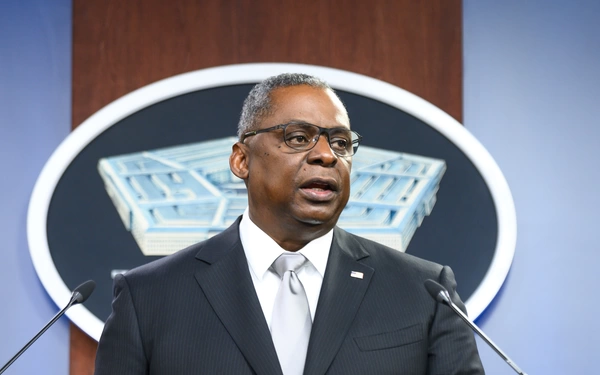Secretary of Defense Lloyd J. Austin III conducted virtual talks on April 16 with his Chinese counterpart, Adm. Dong Jun, Beijing’s Minister of Defense, marking the first direct talk between defense chiefs of the two nations in close to two years.
In a readout, the Pentagon said Austin stressed freedom of navigation in the air and at sea, as Chinese warplanes and ships have intercepted U.S. and allied aircraft, continuously harassed Philippine vessels, and nearly collided with a U.S. destroyer in the past year.
The call signals more open military communication channels between the two nations, an imperative stemming from talks between Chinese leader Xi Jinping and President Joe Biden in November. The Austin-Dong conversation follows a phone call between Biden and Xi earlier this month. Chairman of the Joint Chiefs of Staff Gen. Charles Q. Brown Jr. talked to his counterpart in December.
The teleconference represents Austin’s first conversation with Dong, who assumed the role of China’s defense minister in December. Austin last talked to a Chinese defense minister in 2022, a post then held by Wei Fenghe.
Beijing put high Philippine level talks on ice after a visit to Taiwan by former House Speaker Nancy Pelosi (D-Calif.) in August 2022. The trip drew condemnation from China, which asserts the democratic, self-governing island is a breakaway province. Chinese later claimed U.S. sanctions against former defense minister Li Shangfu prevented high-level talks, though the Biden administration said that was not a restriction imposed by Washington.
Biden reiterated a desire for more dialogue during a recent phone call with Xis and highlighted the importance of talks with China to mitigate any “misunderstandings or miscalculations” during a joint conference with Japanese Prime Minister Kishida Fumio.
During the video call, Austin talked about the importance of respect for high seas freedom of navigation guaranteed under international law, especially in the South China Sea.”
“The Secretary also reiterated that the United States will continue to fly, sail, and operate—safely and responsibly—wherever international law allows,” the Pentagon said.
Military tensions escalated between the two nations in early 2023 when a Chinese surveillance balloon breached continental United States airspace without prior warning. After a week of heightened tensions, the balloon was downed. Beijing rebuffed Austin’s attempt to engage in dialogue with his Chinese counterpart, asserting that the balloon was not a spying platform.
Last year also witnessed incidents involving Chinese fighter jets executing aggressive maneuvers near American aircraft, including one Chinese fighter within 10 feet of a B-52 bomber in the South China Sea. The Pentagon’s annual China report revealed there have been 180 instances of “coercive and risky behavior” between the fall of 2021 and fall of 2023, more than all of the previous decade combined.
The South China Sea remains a hotly contested region. China claims expansive sovereignty over almost the entire area, including territory claimed by the Philippines, Vietnam, Malaysia, Brunei, and Indonesia. U.S. forces, meanwhile, continue to operate in the region, even as the Pentagon has noted an uptick in unsafe and unprofessional incidents by Chinese ships.
Washington has ramped up its military presence in the region in recent years, featuring the B-52 bomber in an ongoing series of joint aerial exercises with Philippine fighter jets. This prompted Beijing’s People’s Liberation Army to condemn the bomber patrol, accusing the Philippines of collaborating with outside countries “to stir up trouble.” The U.S. Navy also continues maritime patrols alongside the Philippine Navy in the waters of the Philippine Exclusive Economic Zone (EEZ).
Pentagon said that the two defense ministers discussed Russia’s invasion of Ukraine and North Korea, which the U.S. wants to more effectively sanction.
